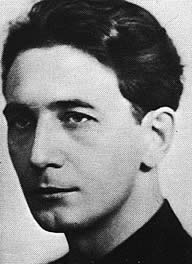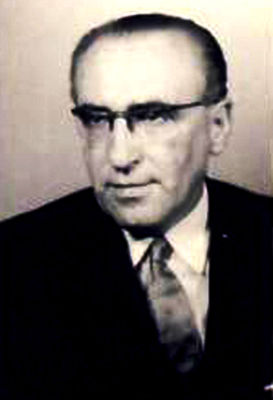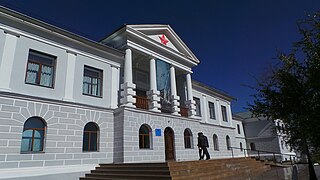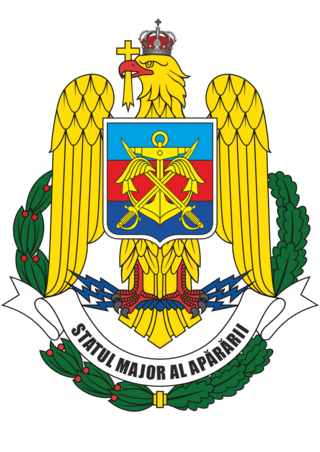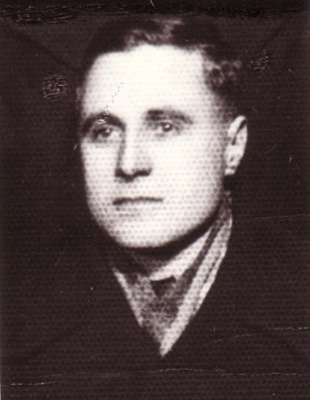Resistance movements
Armed resistance
Anti-German sentiment remained very strong in Romania, both among civilians and soldiers, following the harsh Central Power occupation during World War I, and the fact that, since its arrival in Romania in October 1940, the Wehrmacht behaved like a conqueror, multiplying military requisitions, although the Antonescu regime was Nazi Germany's ally. The partisans were actually peasants starved due to military requisitions and who were fleeing from conscription, anti-fascist townspeople, Jews fleeing the pogroms of the Iron Guard, forced labor and deportation to Transnistria, as well as deserters. Anti-fascist soldiers secretly procured them weapons; between June 1941 and August 1944, 8,600 court-martial sentences were handed down for such actions. [1] As happened in France, the attack on the USSR in June 1941 brought to light the Communist Party [ clarification needed ] and made it join the opponents of fascism. [2]
Romanian allied divisions

Bottom: King Michael I reviewing of the troops, beginning of September 1944
The "Tudor Vladimirescu" and "Horea, Cloșca și Crișan" divisions fought in the Soviet Union against the Germans. Their numbers increased during the campaign against the USSR (June 1941 - August 1944), due to the large number of deserters and Romanian prisoners captured by the Red Army. [3] The "Tudor Vladimirescu" Division was commanded by generals Nicolae Cambrea and Iacob Teclu . The "Horea, Cloșca și Crișan" Division was commanded by general Mihail Lascăr, who had surrendered and joined the Soviets at the Battle of Stalingrad. After initially retreating eastward due to the Axis offensive into the Caucasus, the two divisions advanced westward, by the end of the war reaching Bratislava in Slovakia on April 4, 1945 [4] Humpolec, in Bohemia, on May 7, 1945. [5] : 79 The "Tudor Vladimirescu" Division (6,000 men at formation, 19,000 at the end of the war, mostly peasants) was placed in front of the German or Hungarian divisions and used in direct combat. On the other hand, the "Horea, Cloșca și Crișan" Division (5,000 men at the end of the war, mostly townspeople) was used against Romanian army units acting under the orders of the Antonescu regime, in infiltration and propaganda actions, to try (often successfully, especially during and after the Battle of Stalingrad) rallying soldiers to the Allied cause. As for the Romanian prisoners captured by the Soviets, the choice between captivity in Siberia and enlistment in the "Tudor Vladimirescu" or "Horea, Cloșca și Crișan" Divisions led many of them to choose the second option, even if they had no clear political beliefs. By joining these divisions, they received a left-wing political education under the supervision of political commissars, members of the Romanian Communist Party: Colonel Mircea Haupt (brother of the Communist historian turned French citizen Georges Haupt) for the "Tudor Vladimirescu" Division and Colonel Valter Roman (former member of the International Brigades in the Spanish Civil War and father of the former prime minister of Romania, Petre Roman) for the "Horea, Cloșca and Crișan" Division. After the war, on February 9, 1946, 58 officers from these two divisions were awarded the Order of Victory. [6]
- Romanian and Soviet soldiers talking near Stalingrad, late 1942. The latter were theoretically prisoners of the former, but not for long
- Soviet Forces welcomed as allies by Romanian soldiers in 1944
- Romanian mountain troops in Transylvania, at war with the Axis troops, in 1944
- "Long live the Romanian-Soviet brotherhood of arms!", Romanian stamp from 1948
- Romania's operations against the Axis on the Allied side (in red), between August 24, 1944, and May 7, 1945
Civil resistance
Civil resistance was the result of humanitarian movements such as the Romanian Red Cross, which supported the partisans and those persecuted by the fascist regime. They were the humanitarians of the Romanian Maritime Service , [n 2] who operated throughout the war the passenger ships Transilvania , Medeea, Emperor Trajan and Dacia, together with a dozen other smaller ships, between Constanța and Istanbul, in the service of the organization "Aliya" led by Samuel Leibovici and Eugen Maissner, saving over 60,000 people.
- The passenger ship Dacia built in 1908 at Saint-Nazaire, France
- The passenger ship Emperor Trajan built in 1906 at Saint-Nazaire
- The passenger ship Transilvania in Constanța in 1967, built in 1938 at the shipyard Burnmeister-Wain in Copenhagen, Denmark
More than 1,000 people perished due to the torpedoing of their ships by Soviet submarines or the refusal of the Turkish authorities to allow them to disembark (the tragedies of the ships Struma and Mefküre ). [7] [8] [9] "Aliya" also rented trains that, passing through Bulgaria (which was in the Axis, but did not participate in the fighting with the Allies), transported tens of thousands of Romanian Jews to Turkey (a neutral country).
For their merits, 69 Romanians were awarded the title granted by the Israeli state through the Yad Vashem institute, of " Righteous Among the Nations ". Among them were Viorica Agarici, chairwoman of a local office of the Romanian Red Cross, the pharmacist Dr. Dumitru Beceanu from Iași, and Traian Popovici, the mayor of Cernăuți. [10] The Red Cross sent food and medicine to deportees in Transnistria and persuaded officers not to carry out orders, allowing families like Wilhelm Filderman's or Norman Manea's to survive. The leading World War II fighter ace in Romania, Constantin Cantacuzino, [n 3] organized a network of taking over the downed American airmen in Romania and clandestinely transporting them to Turkey. [11] [12] He was secretly protected by King Michael I and the commander of the Bucharest garrison, General Constantin Sănătescu, who provided him with communication resources and connected him with the clandestine inter-allied mission Operation Autonomous of the SOE.
Political resistance

Political personalities formed, without Antonescu reacting otherwise than by ordering house arrest measures, opposition groups that publicly protested against the regime's policy. Exasperated by the "passive betrayal" of the Romanian dictator, who "has assured the Führer of his loyalty, but tolerates anti-German actions", Joseph Goebbels noted, on February 19, 1941, in his diary: "Antonescu maintains his government with the support of Freemasonry and Germany's enemies. Our local minority is having a hard time. The Reich made such an effort in vain".
In the summer of 1943, all these political groups, including the Communists, united in a "National Council of Resistance", secretly led by the young King Michael I and the leaders of the traditional democratic parties. This council attempted to negotiate in Sweden (through ambassador Frederic Nanu and his agent Neagu Djuvara) and in Turkey (through Prince Barbu Știrbey, descendant of the former Wallachian ruler Barbu Dimitrie Știrbei) about a change of alliance in favor of the Western Allies, requesting instead an Anglo-American landing in the Balkans [n 4] and an occupation of Romania by the armies of the western countries and not by the Red Army. [3] [13]

In order to discuss directly with the Romanian government the possibility of a Romanian defection from the Axis to the Allied camp, a clandestine inter-allied mission of Special Operations Executive (SOE) was parachuted near Bucharest, (Operation Autonomous). [14] : 33 The three agents parachuted into Romania were Lieutenant Colonel Alfred Gardyne de Chastelain, experienced SOE officer, as the leader, Captain Ivor Porter, and Captain Silviu Mețianu, a Romanian who had emigrated to the UK. They were captured by Romanian gendarmerie almost immediately in the area of Plosca. They were held as well-treated prisoners of war at the gendarmerie headquarters in Bucharest. On 23 August 1944 the young King Michael I carried out his well prepared coup d’état which took Adolf Hitler completely by surprise, and Romania then changed sides. The British prisoners were released and that evening the king arranged for de Chastelain to fly to Istanbul, whence he could travel to Cairo and then London to report. Mețianu stayed on for a time and then returned to England. Porter remained to maintain a radio link with SOE headquarters until the British mission arrived in the country. [15]
During the negotiations, Barbu Știrbei accepted the conditions (including the free passage of the Red Army), obtaining the promise of the "guarantee" of the 1939 borders and the restoration of parliamentary democracy under the 1923 Constitution. [13]
Results
The two divisions, Tudor Vladimirescu and Horea, Cloșca și Crișan , were joined by the Romanian army, since on August 23, 1944, the dictator Ion Antonescu was deposed and arrested by King Michael I. Without waiting for the Soviet response to its request for an armistice, Romania declared war on the Axis Powers and committed its 550,000 soldiers to the fight against Nazi Germany. As a result, the front moved 700 km west and south in less than a week, and according to Winston Churchill's estimates, Romania's entry into the war alongside the Allies would avoided the deaths of hundreds of thousands of Russian soldiers and hastened the end of World War II by six months. [16] [17] [3] Once war against the Axis was declared, the Romanian forces, reinforced with partisan recruits and placed under Soviet command, launched their offensive against Hungary, advancing as far as Slovakia.
From August 24, 1944 to May 9, 1945, Romania was an allied country, which allowed it to participate at the Paris Peace Conference of 1947 to recover Northern Transylvania, which had been assigned to Hungary in 1940 as a result of the Second Vienna Award. The military operations of the Romanian Army against the Axis took place between August 24, 1944 (starting from Romania's own territory) and May 7, 1945 (Chotěboř – Humpolec area, 90 km (56 mi) east of Prague). For his contribution to the side of the Allies, King Michael I received the Order of Victory, by order of Joseph Stalin himself.









